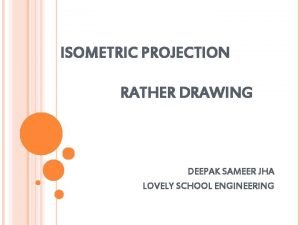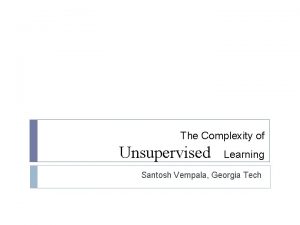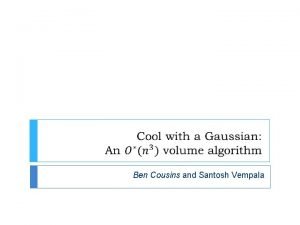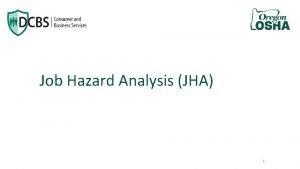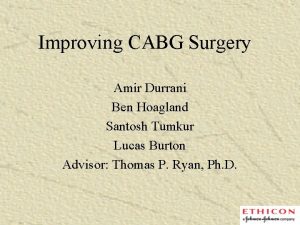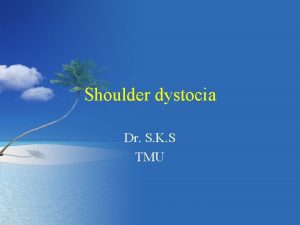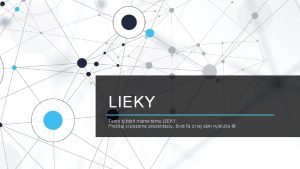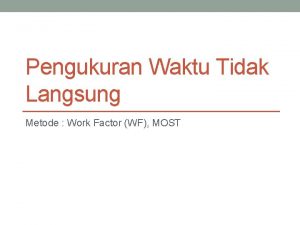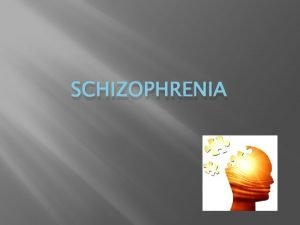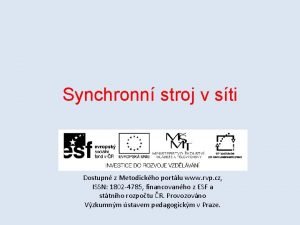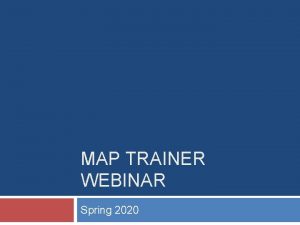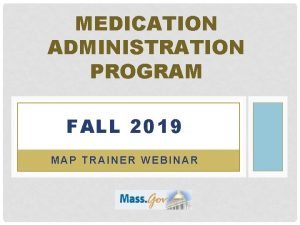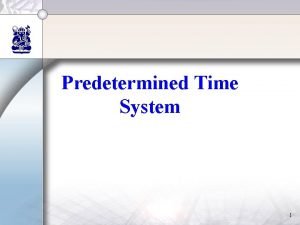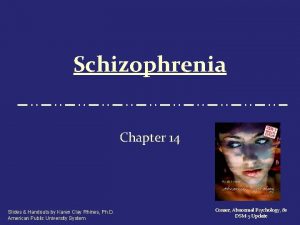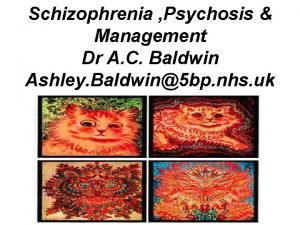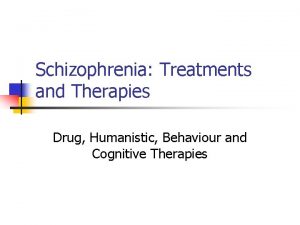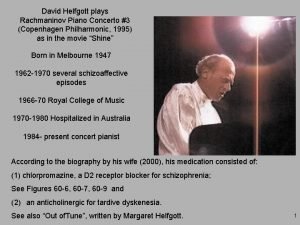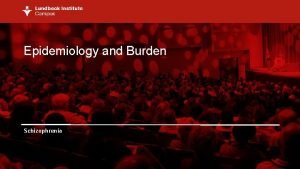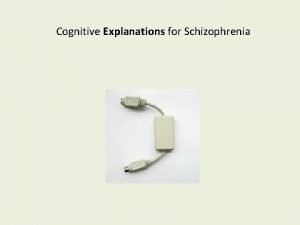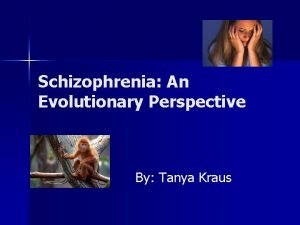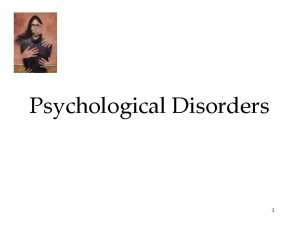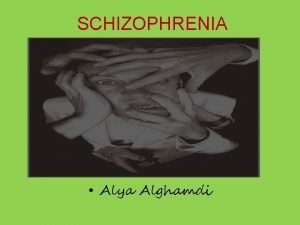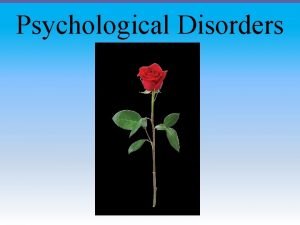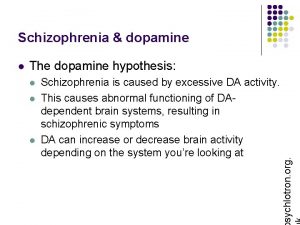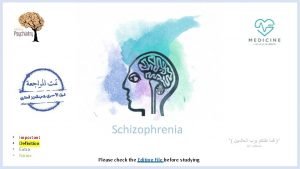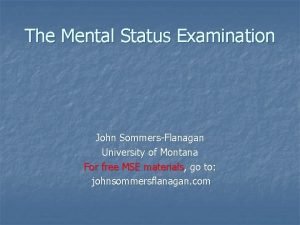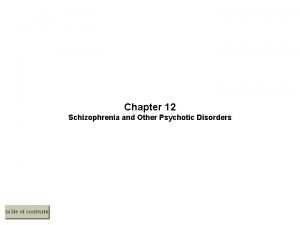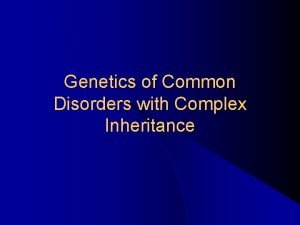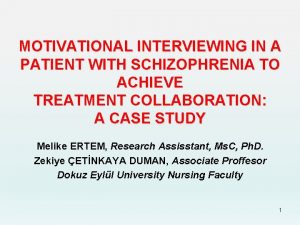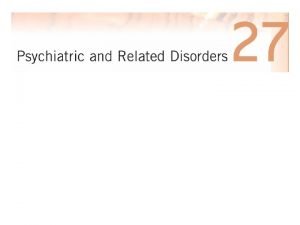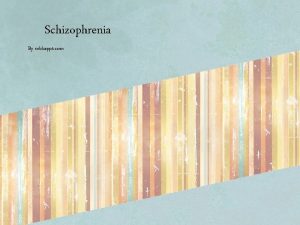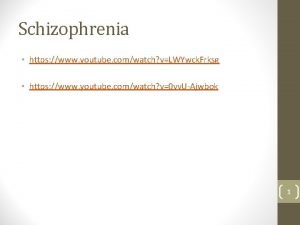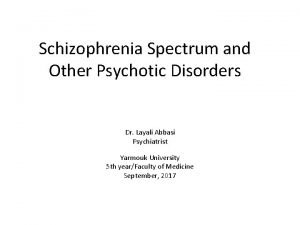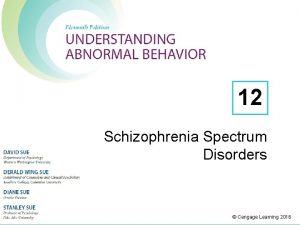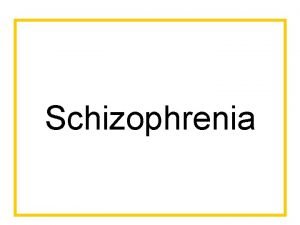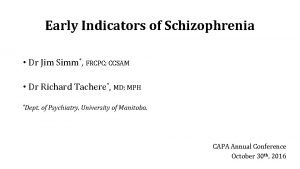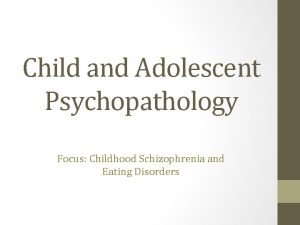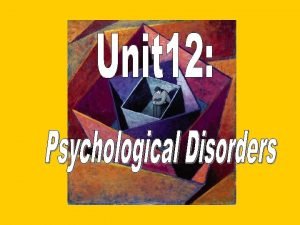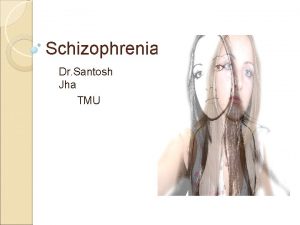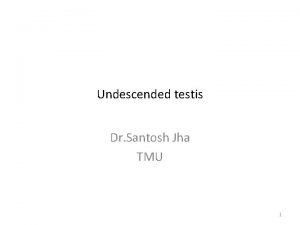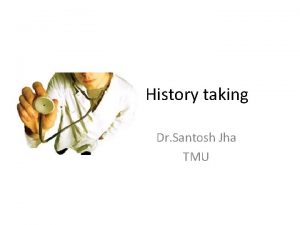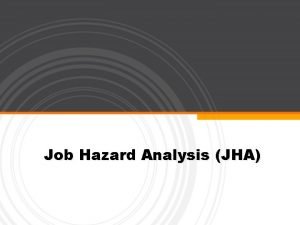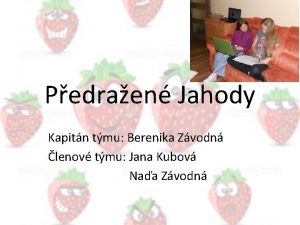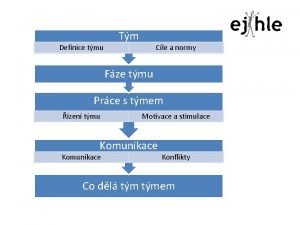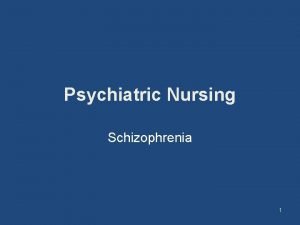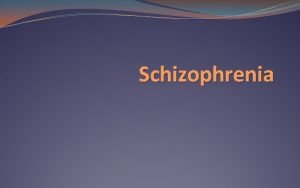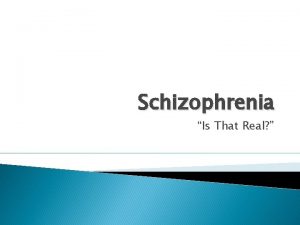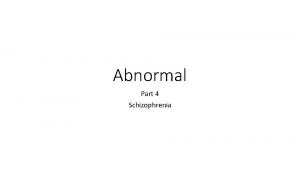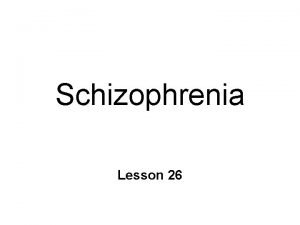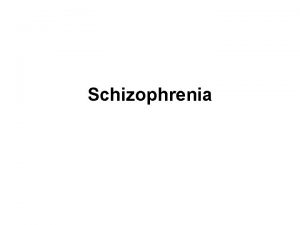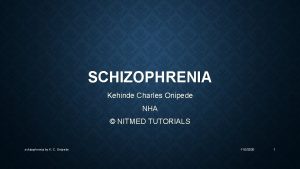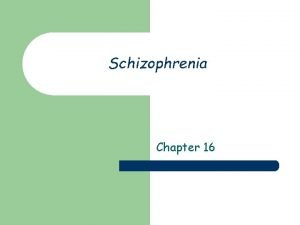Schizophrenia Dr Santosh Jha TMU Schizophrenia is a
















































- Slides: 48

Schizophrenia Dr. Santosh Jha TMU

Schizophrenia is a clinical syndrome of variable, but profoundly disruptive, psychopathology that involves cognition, emotion, perception, and other aspects of behavior ►Psychotic ► Chronic ► Starts early ► Disabling ► Burdening ► Threatening ► Stigmatizing ► Service-consuming

Emil Kraepelin in 1896 Dementia precox Manic Depressive Psychosis hallucinations and delusions

Eugene Bleuler in 1911 -schizophrenia Fundamental symptoms: 4 As Ø Ambivalence-inability to decide for or against Ø Autism- withdrawal into self Ø Affect disturbance- inappropriate affect Ø Association disturbance-loosening of associations, thought disorder

Kurt Schneider Criteria for Schizophrenia 1. First-rank symptoms 1. Audible thoughts 2. Voices arguing or discussing or both 3. Voices commenting 4. Somatic passivity experiences 5. Thought withdrawal and other experiences of influenced thought 6. Thought broadcasting 7. Delusional perceptions 8. All other experiences involving volition made affects, and made impulses 2. Second-rank symptoms 1. Other disorders of perception 2. Sudden delusional ideas 3. Perplexity 4. Depressive and euphoric mood changes 5. Feelings of emotional impoverishment

Epidemiology 24 million people world wide suffer from schizophrenia 1 ~ 100 will develop schizophrenia Equally prevalent in men and women Ages of onset are 10 to 25 years for men and 25 to 35 years for women

□ Non-twin sibling = 8% □ Dizygotic twin = 12 % □ One parent affected = 12 % □ Two parents affected = 40 % □ Monozygotic twin = 47 % □ Male : Female Ratio =1: 1

On set of disease A. Perplexity B. Isolation C. Anxiety and Terror.

Aetiology ► Genetic predisposition ► Stress-Diathesis Model ► Dopamine Hypothesis ► Neuropathology ► Psychoneuroimmunology ► Psychoneuroendocrinology.

C/F Severe disturbances occur in Language and communication, Content of thought, Perception, Affect, Sense of self, Volition, Relationship to the external world, and Motor behavior

Language and communication If things turn by rotation of agriculture or levels in regards and timed to everything: I am referring to a previous document when I made some remarks that were facts also tested and there is another that concerns my daughter she has a lobed bottom right ear, her name being Mary Lou…. Much of abstraction has been left unsaid and undone in this product/milk syrup, and others due to economics, differentials, subsidies, bankruptcy, tools, buildings, bonds, national stocks, foundation craps, weather trades, government in levels of breakages, and fuses in electronics to all formerly “stated” not necessarily factuated.

A psychiatric nurse describes her own thought disturbances as follows Not knowing that I was ill, I made no attempt to understand what was happening, but felt that there was some overwhelming significance in all of this, produced either by God or Satan…. The walk of a stranger on the street could be a “sign” to me which I must interpret. Every face in the windows of a passing streetcar would be engraved on my mind, all of them concentrating on me and trying to pass me sort of

Two patients have described how they feel: I have experienced this process chiefly as a condition in which the integrating mental picture in my personality was taken away and smashed to bits, leaving me like agitated hamburger, distributed evenly throughout the universe. I am like a zombie living behind a glass wall. I can see all that goes on in the world, but I can't touch it. I can't reach it. I can't be in contact with it. I am outside. They are inside, and when I get inside, they aren't there. There is nothing there, absolutely nothing.

DSM-IV-TR Criteria A. Two (or more) of the following during a 1 -month period: (1) delusions (2) hallucinations (3) disorganized speech (e. g. , frequent derailment or incoherence) (4) grossly disorganized or catatonic behavior (5) negative symptoms, i. e. , affective fl attening, alogia, or avolition B. Social/occupational dysfunction: interpersonal relations, or self-care C. Duration: Continuous signs of the disturbance persist for at least 6 months. This 6 -month period must include at least 1 month of symptoms i. e. , activephase symptoms) and prodromal or residual symptoms.

Contd… D. Schizoaffective and mood disorder exclusion : Schizoaffective disorder and mood disorder with psychotic features have been ruled out because either (1) no major depressive, manic, or mixed episodes have occurred concurrently with the active-phase symptoms; or (2) if mood episodes have occurred during active phase symptoms, their total duration has been brief relative to the duration of the active and residual periods E. Substance/general medical condition exclusion: The disturbance is not due to the direct physiological effects of a substance (e. g. , a drug of abuse, a medication) or a general medical condition. F. Relationship to a pervasive developmental disorder: If there is a history of autistic disorder or another pervasive developmental disorder, the additional diagnosis of schizophrenia is made only if prominent delusions or hallucinations are also present for at least a month (or less if successfully treated).

Positive and Negative Symptoms Negative Positive Alogia Hallucinations Affective flattening Delusions Avolition-apathy Bizarre behaviour Anhedonia-asociality Positive formal thought disorder Attentional impairment

F 20 -F 29 Schizophrenia, Schizotypal and Delusional Disorders F 20. 0 F 20. 1 F 20. 2 F 20. 3 F 20. 4 F 20. 5 F 20. 6 F 20. 8 F 20. 9 Schizophrenia Paranoid schizophrenia Hebephrenic schizophrenia Catatonic schizophrenia Undifferentiated schizophrenia Post-schizophrenic depression Residual schizophrenia Simple schizophrenia Other schizophrenia Schizophrenia, unspecified

F 20 -F 29 Schizophrenia, Schizotypal and Delusional Disorders F 21 Schizotypal disorder F 22. 0 F 22. 8 F 22. 9 Persistent delusional disorders Delusional disorder Other persistent delusional disorders Persistent delusional disorder, unspecified F 23 Acute and transient psychotic disorders F 23. 1 Acute polymorphic psychotic disorder with symptoms of schizophrenia F 23. 2 Acute schizophrenia-like psychotic disorder F 23. 3 Other acute predominantly delusional psychotic disorders F 23. 8 Other acute and transient psychotic disorders F 23. 9 Acute and transient psychotic disorder, unspecified

F 20 -F 29 Schizophrenia, Schizotypal and Delusional Disorders F 24 Induced delusional disorder F 25. 0 F 25. 1 F 25. 2 F 25. 8 F 25. 9 Schizoaffective disorders Schizoaffective disorder, manic type Schizoaffective disorder, depressive type Schizoaffective disorder, mixed type Other schizoaffective disorders Schizoaffective disorder, unspecified F 28 Other nonorganic psychotic disorders F 29 Unspecified nonorganic psychosis

F 20. 0 Paranoid Schizophrenia Paranoid schizophrenia is characterized mainly by delusions of persecution, feelings of passive or active control, feelings of intrusion, and often by megalomanic tendencies also. The delusions are not usually systemized too much, without tight logical connections and are often combined with hallucinations of different senses, mostly with hearing voices. Disturbances of affect, volition and speech, and catatonic symptoms, are either absent or relatively inconspicuous.


F 20. 1 Hebephrenic Schizophrenia Hebephrenic schizophrenia is characterized by disorganized thinking with blunted and inappropriate emotions. It begins mostly in adolescent age, the behavior is often bizarre. There could appear mannerisms, grimacing, inappropriate laugh and joking, pseudophilosophical brooding and sudden impulsive reactions without external stimulation. There is a tendency to social isolation. Usually the prognosis is poor because of the rapid development of "negative" symptoms, particularly flattening of affect and loss of volition. Hebephrenia should normally be diagnosed only in adolescents or young adults. Denoted also as disorganized schizophrenia

pseudophilosophical brooding

F 20. 2 Catatonic Schizophrenia Catatonic schizophrenia is characterized mainly by motoric activity, which might be strongly increased (hyperkinesis) or decreased (stupor), or automatic obedience and negativism. We recognize two forms: ◦ productive form — which shows catatonic excitement, extreme and often aggressive activity. Treatment by neuroleptics or by electroconvulsive therapy. ◦ stuporose form — characterized by general inhibition of patient’s behavior or at least by retardation and slowness, followed often by mutism, negativism, fexibilitas cerea or by stupor. The consciousness is not absent.

motoric activity~hyperkinesis or stupor or automatic obedience and negativism.

schizophrenic patient stands in a catatonic position

F 20. 3 Undifferentiated Schizophrenia Psychotic conditions meeting the general diagnostic criteria for schizophrenia but not conforming to any of the subtypes in F 20. 0 F 20. 2, or exhibiting the features of more than one of them without a clear predominance of a particular set of diagnostic characteristics. This subgroup represents also the former diagnosis of atypical schizophrenia.

F 20. 4 Post schizophrenic Depression A depressive episode, which may be prolonged, arising in the aftermath of a schizophrenic illness. Some schizophrenic symptoms, either „positive“ or „negative“, must still be present but they no longer dominate the clinical picture. These depressive states are associated with an increased risk of suicide.

F 20. 5 Residual Schizophrenia A chronic stage in the development of schizophrenia with clear succession from the initial stage with one or more episodes characterized by general criteria of schizophrenia to the late stage with longlasting negative symptoms and deterioration (not necessarily irreversible).

F 20. 6 Simple Schizophrenia Simple schizophrenia is characterized by early and slowly developing initial stage with growing social isolation, withdrawal, small activity, passivity, avolition and dependence on the others. The patients are indifferent, without any initiative and volition. There is not expressed the presence of hallucinations and delusions.

F 21 Schizotypal disorder This disorder is characterized by eccentric behavior and by deviations of thinking and affectivity, which are similar to that occurring in schizophrenia, but without psychotic features and expressed symptoms of schizophrenia of any type.

F 22 Persistent Delusional Disorders Includes a variety of disorders in which long -standing delusions constitute the only, or the most conspicuous, clinical characteristic and which cannot be classified as organic, schizophrenic or affective. Their origin is probably heterogeneous, but it seems, that there is some relation to schizophrenia.

F 22. 0 Delusional Disorder A disorder characterized by the development of one delusion or of the group of similar related delusions, which are persisting unusually long, very often for the whole life. Other psychopathological symptoms — hallucinations, intrusion of thoughts etc. are not present and are excluding this diagnosis. It begins usually in the middle age.

F 23 Acute and Transient Psychotic Disorders The criteria should be the following features: ◦ acute beginning (to two weeks) ◦ presence of typical symptoms (quickly changing “polymorphic symptoms”) ◦ presence of typical schizophrenic symptoms. Complete recovery usually occurs within a few months, often within a few weeks or even days. The disorder may or may not be associated with acute stress, defined as usually stressful events preceding the onset by one to two weeks.

F 24 Induced Delusional Disorder A delusional disorder shared by two or more people with close emotional links. Only one of the people suffers from a genuine psychotic disorder; the delusions are induced in the other(s) and usually disappear when the people are separated. The psychotic disorder of the dominant member of this dyad is mainly, but not necessarily, of schizophrenic type. The original delusions of dominant member and his partner are usually chronic, either persecutory or megalomanic.

F 25 Schizoaffective Disorders Episodic disorders in which both affective and schizophrenic symptoms are prominent (during the same episode of the illness or at least during few days) but which do not justify a diagnosis of either schizophrenia or depressive or manic episodes. Patients suffering from periodic schizoaffective disorders, especially with manic symptoms, have usually good prognosis with full remissions without any remaining defects.

Other subtypes Ø Pseudoneurotic schizophrenia (Hoch & Polatin— predominant neurotic symptoms last for years & has poor prognosis (pan-anxiety, pan-neurosis, pan-sexuality) Schizophreniform disorder--< 6 months and good prognosis Ø Oneiroid schizophrenia Ø Van Gogh syndrome Ø Late paraphrenia Ø Pfropf schizophrenia Ø

Etiology of Schizophrenia The etiology and pathogenesis of schizophrenia is not known It is accepted, that schizophrenia is „the group of schizophrenias“ which origin is multifactorial: ◦ internal factors – genetic, inborn, biochemical ◦ external factors – trauma, infection of CNS, stress

Biological theroies Ø Genetic hypothesis Ø Biochemical theories Ø Brain imaging Psychological theories Ø Stress Ø Family theories Ø Information processing hypothesis Ø Psychoanalytical theories Socio-cultural theories


Differential Diagnosis 1. Schizotypal Disorder 2. Acute &Transient Psychotic Disorders 3. Delusional Disorders 4. Schizoaffective Disorder 5. Bipolar Disorder 6. Psychotic Depression 7. Substance-Induced Psychotic Disorders 8. Psychotic Disorders due to OBS or GMC 9. Quasi-Psychotic Presentations in the course of: 1. Mental Retardation 2. Some Personality Disorders 3. Obsessive-Compulsive Disorder 3. Factitious Disorder 4. Malingering?

Prognosis Factors associated with good prognosis include: : 1. Sudden Onset / Precipitating Factors 2. Short Episode 3. Minimal Negative Symptoms 4. Paranoid Type 5. Female Gender 6. No Previous Psychiatric History 7. Prominent Affective Symptoms 8. Older Age of Onset 9. Being Married 10. Good Previous Personality 11. Good Work Record 12. Good Psychosexual Adjustment 13. Good Social Relationships 14. Good Compliance.

Management. Physical Treatment A. Psychopharmacological: 1. Antipsychotics: Typical Antipsychotics Atypical (2 nd Generation). 2. Adjunct Medications B. Electroconvulsive Therapy (ECT). (mostly in Catatonic Stuper )

Management. : Psychological Interventions: . Supportive Therapy Individual Psychotherapy Cognitive Behavioral Therapy Family Therapy Marital Therapy Psychoeducation

Management Socio-Occupational Rehabilitation Occupational Therapy Social Skill Training Residential Support Community-Outreach Services Sheltered Employment

Drug Treatment of Schizophrenia 1. Typical Antipsychotics: A. Oral: ► Chlorpromazine 100 mg tid ► Haloperidol 5 mg tid B. Aqueous Injections: ► Chlorpromazine 50 mg IM (±Promethazine 50 mg) ► Haloperidol 5 mg IM (±Promethazine 50 mg) C. Depot Injections: ► ► Fluphenazine Decanuate 25 mg IM once per month Haloperidol Decanuate 100 mg IM once per month Flupenthixol Decanuate 40 mg IM once per month Clopenthixol Decanuate 200 mg IM once per month.

Drug Treatment of Schizophrenia - 2 Atypical Antipsychotics: A. Oral: ► Risperidone 2 -6 mg per day ► Olanzapine 5 -10 mg per day ► Clozapine 300 -900 mg per day (for resistant cases only) B. long-acting: ► Risperidone 25 -50 mg IM every two weeks.

3. Adjunct Medications: Anxiolytics / sedatives Antidepressants Anticholinergics Mood stabilizers
 Isometric
Isometric Framework decision 2008/913/jha
Framework decision 2008/913/jha Which of the following religions does pi not practice
Which of the following religions does pi not practice Madhulika jha
Madhulika jha Vidyanand jha
Vidyanand jha Santosh vempala
Santosh vempala Santosh vempala
Santosh vempala Hazards
Hazards Santosh thomas
Santosh thomas Santosh kumar swain kiit
Santosh kumar swain kiit Tmu crazy colors
Tmu crazy colors Dky tmu
Dky tmu Work factor adalah
Work factor adalah Schizophrenia def
Schizophrenia def Fázování na tmu
Fázování na tmu Ma.tmuniverse
Ma.tmuniverse Tmu map test
Tmu map test 1 tmu berapa detik
1 tmu berapa detik Sel tmu
Sel tmu Hebephrenic schizophrenia
Hebephrenic schizophrenia Loose associations psychology
Loose associations psychology Ashley baldwin
Ashley baldwin Humanistic approach to schizophrenia
Humanistic approach to schizophrenia Genes schizophrenia
Genes schizophrenia Schizophrenia def
Schizophrenia def Prevalence of schizophrenia
Prevalence of schizophrenia Cognitive explanations of schizophrenia
Cognitive explanations of schizophrenia Tanya kellet
Tanya kellet Negative explanatory style
Negative explanatory style Alya alghamdi
Alya alghamdi Schizophrenia types
Schizophrenia types Types of schizophrenia
Types of schizophrenia Schizophrenia's literal translation means
Schizophrenia's literal translation means Dopamine hypothesis of schizophrenia ppt
Dopamine hypothesis of schizophrenia ppt Avolition definition schizophrenia
Avolition definition schizophrenia Mse report sample
Mse report sample First-line treatment for schizophrenia
First-line treatment for schizophrenia Chapter 12 schizophrenia spectrum disorders
Chapter 12 schizophrenia spectrum disorders Schizophrenia genetic
Schizophrenia genetic Motivational interviewing schizophrenia
Motivational interviewing schizophrenia Duman
Duman Thought insertion
Thought insertion Symptoms of schizophrenia
Symptoms of schizophrenia Schizoaffective disorder
Schizoaffective disorder Chapter 12 schizophrenia spectrum disorders
Chapter 12 schizophrenia spectrum disorders Acute dystonia pathophysiology
Acute dystonia pathophysiology Dr. tachere
Dr. tachere Example of loose associations in schizophrenia
Example of loose associations in schizophrenia How do you get schizophrenia
How do you get schizophrenia
